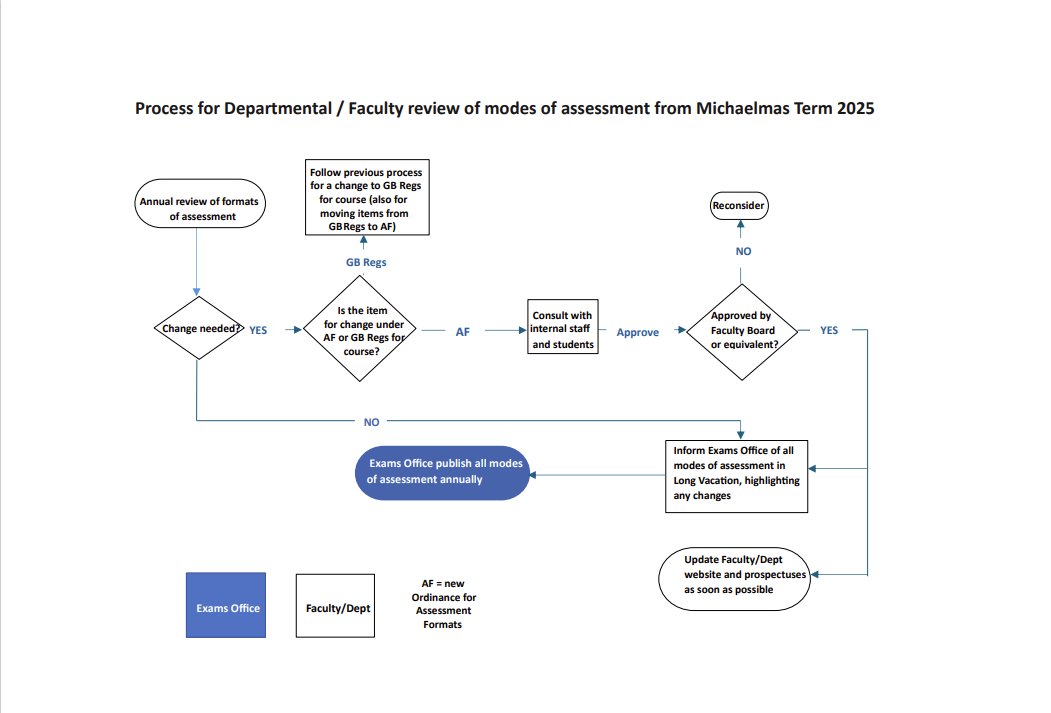Ordinance for Assessment Formats
In June 2023 the University's General Board agreed to introduce a new Ordinance for Assessment Formats, to take effect in October 2025: Joint Report of the Council and the General Board on the regulation of the methods and modes of assessment in University examinations. The new Ordinance is intended to enable Faculties and Departments the flexibility to examine taught courses using a variety of established formats, listed below. Dissertations and vivas/oral examinations will remain listed in individual course regulations and changes will require approval through the usual channels.
(a) Coursework
(b) In-person invigilated handwritten examination
(c) In-person invigilated digital examination*
(d) Digital non-invigilated open-book examination
(e) Presentations
*Due to funding constraints it will not be possible to offer (c) In-person invigilated digital examinations in 2025-26 to any faculty or department not already involved in the pilot.

The Cambridge Centre for Teaching and Learning (CCTL) has produced a set of expectations for each format, below, and good practice guidance can be found on their website here Assessment at Cambridge | Cambridge Centre for Teaching and Learning.
- For the purpose of the Assessment Ordinance, coursework is defined as a set assignment of work that is undertaken over a period of time.
- Parameters for coursework include a fixed date for submission (with a possibility of extension on a case-by-case basis) and sometimes a fixed word limit.
- Coursework may be undertaken by an individual student or a group of students. Where undertaken by a group, clear advice about marking practices should be shared with students in advance.
- Coursework may encompass a range of discipline-specific, innovative and inclusive assessment modes and methods.
- Coursework could take the form of a single piece of work, or a portfolio of essays or assignments.
- For example, this may include but is not limited to essays, research posters, reports, project portfolios, videos.
- Clear marking criteria, instructions on formatting and citation guidelines should be provided in advance.
- For the purpose of the Assessment Ordinance, there are three examination-based formats for assessment: in-person invigilated handwritten examinations; in-person invigilated digital examinations; digital non-invigilated open-book examinations. The following expectations apply to all three formats. Specific expectations for each of the three formats then follow below.
- The assessment will be for a limited time, and all students will have the same start and end time for the examination (with exceptions for those students who have approved adjustments from the EAMC).
- Examination marking criteria should be made available to students and supervisors before the examination. If converting an existing closed-book examination into an open-book examination (whether in-person or remote), these will require review and adjustment.
- Clear instructions should be provided to students about referencing and citations prior to the examination.
- In-person handwritten examinations require students to hand-write their responses to the examination (with exceptions for those students who have approved adjustments from the EAMC).
- In-person handwritten examinations assume the examination will take place synchronously in an invigilated University examination hall or within examination conditions administered locally.
- In-person handwritten examinations are either closed-book or students may be permitted to bring written notes and texts into the examination hall with the express permission of the relevant Examinations Board and advance notification to the Examinations Team.
- In-person digital examinations require students to type their responses to the examination (with exceptions for those students who have approved adjustments from the EAMC).
- In-person digital examinations assume the examination will take place synchronously in an invigilated University exam hall.
- In-person digital examinations are either closed-book or students may be permitted to bring written notes and texts into the examination hall with the express permission of the relevant Examination Board and advance notification to the Examinations Team.
- A presentation may be prepared and given by an individual or by a group.
- Where a presentation is prepared and given by a group, clear advice about marking practices / criteria should be shared with students in advance.
- A presentation includes a delivery of content with a possible opportunity for questions and/or discussion following the presentation.
- A presentation may be given online or in-person. The content itself may be recorded in advance, but must be presented live; in contrast, a recorded video submitted for assessment without being ‘presented’ by the student would be considered coursework.
- A presentation can be delivered solely to the assessors / examiners or to the assessors / examiners alongside a wider audience, such as peers on the course.
- Clear marking criteria, instructions on formatting, and citation guidelines should be provided in advance.
- A presentation is considered distinct from a ‘viva’, which would have to be approved as part of the course regulations. A presentation is didactic in nature, even if delivered solely to the assessors / examiners and/or involving opportunity for questions or discussion, whereas the focus of a viva is dialogic.
